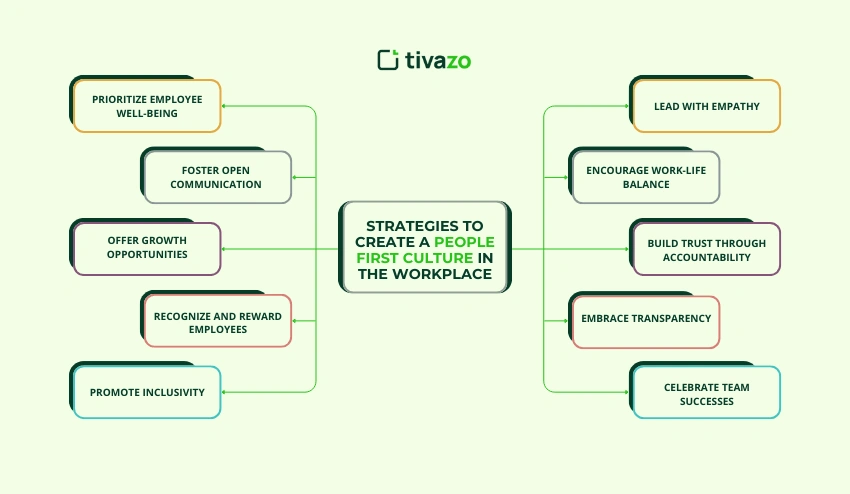Think about coming to a job where people feel truly appreciated, listened to, and empowered on a daily basis-that is what a people first culture is all about.
People first culture is not just about policies and perks, but rather it is an approach to culture that puts an employee’s well-being, engagement, and professional development first. Organizations that follow this strategy develop trust, collaboration, and retain the best talent. Research has shown that employee-centric cultures in companies increase their engagement and overall performance by up to 25% percent.
A people first culture implies the establishment of a favorable working atmosphere in which recognition, inclusivity, and developmental opportunities become a regular part of everyday life. Empowerment of employees, encouragement of open communication, and recognition of success convert organizations into successful ecosystems, where individuals and companies can flourish. Leaders who subscribe to this philosophy are able to unlock the untapped potential and motivate the teams to give their best efforts at all times.
👉You May Also Like: What Are the Different Types of Workplace Culture?
What does a people first culture mean?
A people first culture is a workplace philosophy that prioritizes employees’ well-being, engagement, and growth above short-term business gains. It emphasizes respect, inclusivity, recognition, and empowerment, creating an environment where employees feel valued and motivated.
The people first culture says, the tech industry is in practice, and that means that companies invest heavily in employee development, have flexible working hours, and have open and transparent communication.
Why a People-First Approach Is Key to Employee Engagement
A people first philosophy is necessary in motivating meaningful employee engagement since it makes employees the center of all decisions and initiatives. Employees feel appreciated and encouraged to give their best work when the organizations focus on well-being, recognition, and professional development. Recent research suggests that organizations with people first culture experience much greater engagement, retention rates, and inter-team collaboration. A people first philosophy will result in a feeling of trust and loyalty among employees by encouraging a positive workplace atmosphere where opinions are encouraged and successes are applauded.
The people first approach is not just about perks and benefits but rather a way of creating a culture in the workplace that fosters open communication, inclusivity, and empowerment. Feeling listened to and supported, employees will be more inclined to enthusiastically accept their positions, be proactive, and make a difference. By addressing the needs and development of teammates, organizations can turn a workplace into a vibrant ecosystem where employees and the company can prosper. A people-first culture is not a strategy; it is the basis of long-term employee engagement.
10 Strategies to Create a People First Culture in the Workplace
The establishment of a people first culture in the work environment demands deliberate measures that focus on employee welfare, involvement, and development. Organizations are able to create the correct environment in the workplace, which encourages teams to work towards success in the long term by employing the best practices.

1. Prioritize Employee Well-Being
A people first culture is built on employee well-being. Employees feel appreciated and encouraged when their physical, mental, and emotional well-being is the priority of the organization. Programs like wellness programs, availability of counseling services, and ergonomic work arrangements help employees succeed in their personal lives and careers.
Another essential aspect is flexible work arrangements. Companies can prove that they value personal life and keep working, showing that they do not intrude on it, providing the opportunity to work remotely, flexibly, or in a hybrid manner. This creates an atmosphere of support in the workplace where the employees feel more engaged and encouraged to deliver their best.
Research indicates that organizations that invest in the well-being of employees have high retention rates, enhanced satisfaction, and greater performance. An environment where people feel looked after and therefore less burnout and more successful in the long-term organizational performance is developed through a people first culture that focuses on well-being.
2. Foster Open Communication
A people first culture can only be developed through transparent and consistent communication. Employees need to feel that their voice is listened to and appreciated, and it creates trust and cooperation. Open communication lines, like town halls, suggestion boxes, or anonymous feedback forms, generate a favourable working atmosphere where the ideas circulate.
Leaders are very important in setting communication behavior patterns. Whenever managers listen to employee concerns and respond, the teams will feel more connected and understood. Open-door policies, frequent one-on-one check-ins, and team meetings affirm a people first culture.
Also, effective communication on goals, changes, and expectations in an organization places the employees in line with the company’s mission. The focus on transparency and dialogue helps to enhance the engagement level, minimize the misunderstanding, and support the values of people first culture.
3. Offer Growth Opportunities
Expanding career opportunities is a major component of a people first culture. When employees believe they have a clear way of progressing, they get motivated to perform and be loyal to the organization. They contribute to the development of new skills and the promotion of the careers of people through training programs, workshops, mentorship, and cross-departmental projects.
Professional development programs also create a good working environment since they motivate employees to own the development process. When supported leaders promote skill development, career planning, they are showing their commitment towards employee success, which adds weight to the people-oriented philosophy of an organization.
Studies have shown that employees who see a chance to develop are 2.5 times more engaged as compared to those who do not. Through development, companies are able to develop talent, boost retention, and reinforce the base of a sustainable people first culture.
4. Recognize and Reward Employees
Acknowledgement is a strong instrument in the creation of a people first culture. Rewarding employees for both large and small accomplishments enhances the value of employees and boosts morale. Programs like employee of the month, peer-to-peer recognition, and milestone celebration make the workplace supportive.
Rewards need not be monetary at all times. It can be as effective as public recognition, personalized thank-you letters, or skill development opportunities. Feeling valued makes employees more engaged, cooperative, and devoted to organizational objectives.

Integrating recognition into everyday working processes enhances the dynamics of a team and promotes steady performance. People first organizations that embrace recognition enjoy increased productivity, better engagement, and a better working environment.
5. Promote Inclusivity
People first culture is a culture that prospers in an environment where inclusivity is given the first priority. Diversity promotes innovation, creativity in the resolution of problems, and better decision-making. Policies that support equal opportunity and equity should be developed to make all employees feel important and listened to.
The positive working environment can be provided by means of Employee Resource Groups (ERGs), diversity training programs, and mentorship programs so that everyone feels a part of the team. The inclusive practices reinforce teamwork and assist the team to work optimally.
Research has found that inclusive workplaces enjoy more engagement, retention, and innovation. Incorporating inclusivity into the very essence of people first culture, organizations will provide a setting in which every employee will be able to flourish and make a significant contribution.
6. Lead with Empathy
A people first culture features empathetic leadership. Leaders who are sensitive to the struggles of the employees, active listeners, and compassionate people establish better relationships in the workplace. Empathy builds trust and helps to make employees feel free to contribute ideas and concerns.
Open feedback systems, one-on-one meetings, and coaching sessions also assist the leaders in getting to know their teams at the individual level. This strategy strengthens a people-oriented organization, in which people feel appreciated and nurtured both at work and personal issues.
Empathy also promotes effective decision-making since leaders take into consideration the human factor behind the changes in the organization. The engagement, loyalty, and morale of teams increase when companies develop a people first culture by employing empathetic leadership.
7. Encourage Work-Life Balance
A people first culture depends on a work-life balance. Employees who are overworked tend to experience burnout, stress, and reduced productivity. Organizations can provide a conducive working environment by providing flexible working hours, remote working, and policies that do not interfere with personal time.
The promotion of balance also involves asking employees to have a break, take a vacation time and unwind after a day. By being healthy work-life role models, leaders increase the likelihood of their teams adopting the same behavior, increasing engagement and satisfaction.

Studies have found that an employee with a balanced life is more focused, motivated, and loyal. People first culture that observes personal boundaries enhances retention, productivity, and general performance of the organization.
8. Build Trust Through Accountability
Accountability enhances a people first culture as it promotes clarity, fairness, and reliability. When expectations are transparent and uniform, employees feel more secure in the job they have, and this leads to a good working environment in which trust prevails.
Leaders who take themselves and their teams responsible show integrity and develop credibility. Giving positive feedback, keeping promises, and responding to problems quickly will make all people feel responsible and appreciated in the organization.
Collaboration, innovation, and engagement are also promoted by trust. Firms that incorporate accountability in the first culture of their people generate a clear workforce that is empowered and that is aligned with organizational objectives.
9. Embrace Transparency
A people first culture must be nurtured by transparency. Employees desire to know the objectives, problems, and decision-making of the company. Transparency promotes trust and makes everyone feel part of the happenings in the organization, making it people-oriented.
Communication of performance metrics, updates, and strategic plans on a regular basis makes the employees feel knowledgeable and empowered. This model promotes teamwork, creativity, and team ownership.
Companies that embrace transparency enjoy more employee engagement, loyalty, and satisfaction. An honest and open culture of people first will create better relationships and long-term success.
10. Celebrate Team Successes
Team celebration enhances a people first culture and boosts morale. Camaraderie and motivation can be achieved by recognizing collective milestones, team-building events, or project completions.
Recognition by the public and peer appreciation also helps the employees to support and uplift one another, developing a supportive working environment. Employees are bound to be engaged and productive when they feel that they are in a winning team.
Research shows that higher employee satisfaction and retention are reported in teams that celebrate successes frequently. Organizations also instill recognition in daily operations to develop a people first culture that is sustainable and provides employees with the feeling that they are valued, motivated, and inspired to perform excellently.
These 10 strategies will assist organizations in developing a successful people first culture that empowers employees and makes the business successful. Companies can create a favorable work environment by putting well-being, growth, and recognition into the spotlight, whereby teams are appreciated, inspired, and encouraged daily.
Conclusion
The idea of people first culture is not merely a strategy, but a culture that leads to engagement, loyalty, and long-term business success. By focusing on employees’ welfare, development, appreciation, and inclusion, organizations have the chance to create a positive work environment where teams feel appreciated and motivated in their daily lives. The application of these strategies will make workplaces successful ecosystems that are beneficial to the employees and the organization. Are you willing to begin the culture of people first in your company?




